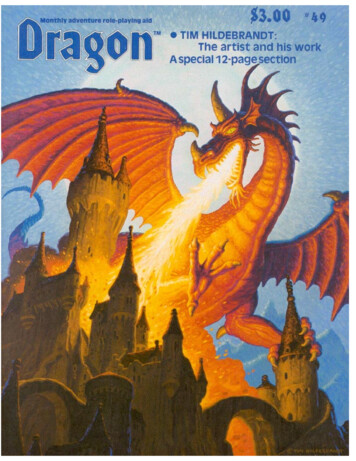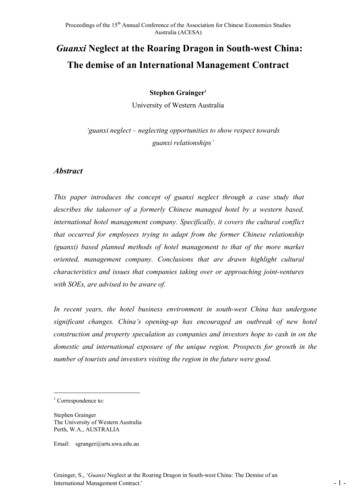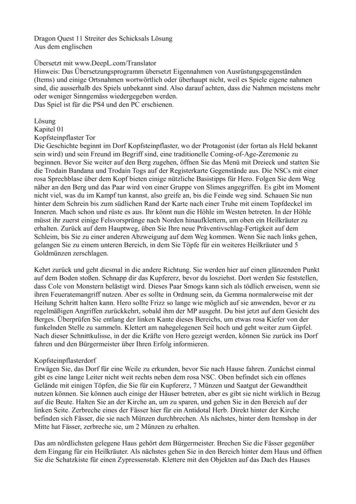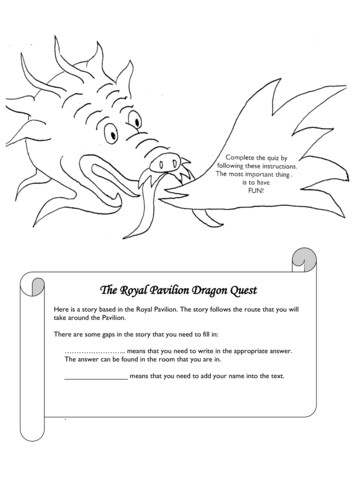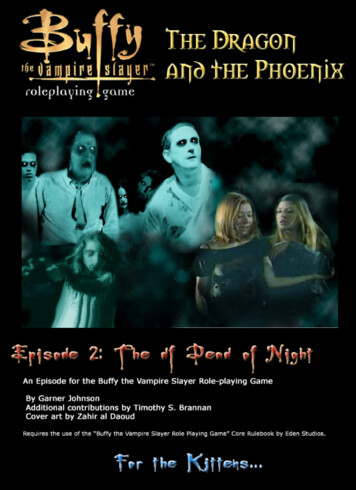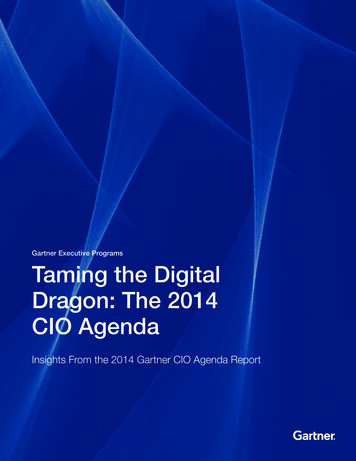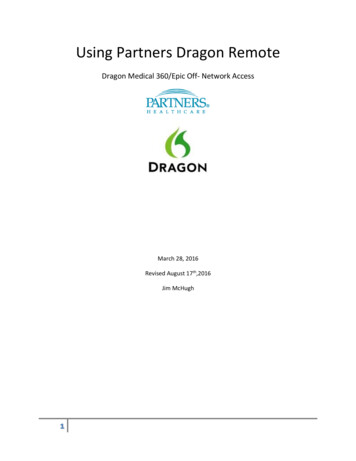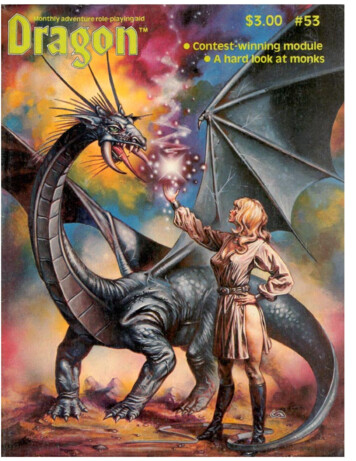
Transcription
DragonSeptember 19811
DragonVol. VI, No. 3Vol. VI, No. 3There is a bit of a new trend in gamingthat I find a bit disturbing, and perhaps itshould be food for thought for all of us. Irefer to the recent interest in so-called“live” games, especially of the “assassin”or “killer” varieties.These types of games are billed asrole-playing games, and in the strictestdefinition of the word, I guess they are.What disturbs me is that they are beingequated by the non-gaming public (or bythose with limited gaming experience)with heroic fantasy and science fictionrole-playing games — and the types arenot the same.I’m not picking on Steve Jackson here,although he claims his recently releasedKlLLER game is the first commerciallyavailable set of rules for the genre. Myfirst exposure to “live” games was manyyears ago in college, and I’ve seen themplayed several times since then. “Live”games are also not necessarily of theassassin type either — I’ve known of afew LOTR interpretations, also.Live games may be role-playing games,but they are not the same as what wehave come to call adventure role-playinggames (D&D and AD&D games, Traveller, RuneQuest, etc.). Live games require physical action. In the assassingames, this involves stalking a persondesignated as a target (the stalker maybe a target as well) and performing a“kill” with, for example, a squirt of a water pistol to represent a gun shot, or anAlka-Seltzer tablet to represent poison.The attraction of this type of simulation escapes me. Steve says in his ads forKlLLER that the game will “test your reflexes and ingenuity in a way no papergame ever will.” I’m sure it would, butwhy bother? If I want to test my reflexesagainst another person, I can think ofmany ways that do not involve even simulated weapons — or, if weapons are thepoint, we could meet at the local skeetand trap club. Ingenuity? Working onthis magazine tests it about as fully as Icare to have it tested. But, I digress.What we have here is a type of game inwhich ingenuity and strategy are secondary to the performance of physical actions, and the only concessions to roleplaying are an alias and performing featsof thespian skill like “dying in a very realistic or artistic fashion” (worth 5 points inKILLER). While this is role-playing, it islimited to the extent of a person’s physical abilities and acting talent.“Live” role-playing games are muchmore an exhibition (like a Wild Westshoot-out on a movie lot or an SCA demonstration) than actual game playing.I’m for any activity that is fun for theparticipants and harmless to everyoneelse. But the “live” role-playing games,particularly the assassin type, may notbe entirely harmless to everyone else.Physical games — spectator sports, forexample — can cause harm to the participants. But the spectators of those sportsare willing spectators, and they aren’t onthe playing field while the game is goingon. “Live” games are often played in public. Sooner or later there will be an injuryto a “spectator” (bystander), and if ithappens to occur in the wrong place atthe wrong time, the headline will readsomething like, “Student Injured in Roleplaying Game at Local College.” And allof us sitting at tables with paper-andpencil role-playing games will be equated with those folks wearing masks-andchasing each other around with waterpistols and bean shooters.Perhaps a more serious consideration,though, is how the non-gaming public isgoing to view these games even if no onegets hurt. Most of us, at one time oranother, have been called upon to explain our reasons for playing paper-andpencil adventure role-playing games, particularly the heroic fantasy type. Despiteour best efforts to explain, there are stillmany who view such a pastime as somesort of escape from reality, or worse, justfrom seeing some people sitting arounda table with books and dice! How arethey going to look at people chasingeach other and playing assassin?I fail to see the attraction for “live” roleplaying (and in some cases I think it isjust an excuse for a good water balloonfight), but I’ll grant that the type has itsplace in the overall list of games that maybe played. But, like anything else in thisworld, perceptions (mine included) depend upon perspective. While I grantthat there is a place for “live” roleplaying, others will not. And it is a verysmall step from condemning “live” roleplaying games to condemning all roleplaying games.September 1981Publisher. . . . . . . . . . . . . . . Jake JaquetEditor-in-Chief. . . . . . . . . . . Kim MohanEditorial staff . . . . . . . . . . . Bryce KnorrMarilyn MaysGali SanchezSales. . . . . . . . . . . . . . Debbie ChiusanoCirculation . . . . . . . Corey KoebernickOffice staff . . . . . . . . . . . . . Cherie Knull.Roger RauppContributing editors. . . . Roger MooreEd GreenwoodThis issue’s contributing artists:Clyde CaldwellBruce WhitefieldRoger RauppWill McLeanDexter PrattSusan CollinsJames Holloway J. D. WebsterHarry QuinnPhil FoglioDRAGON magazine is published monthly byDragon Publishing, a division of TSR Hobbies,Inc. The mailing address of Dragon Publishingis P.O. Box 110. Lake Geneva WI 53147: telephone (414) 248-8044.DRAGON magazine is available at hundredsof hobby stores and bookstores throughout theUnited States and Canada, and through a limited number of overseas outlets. The magazinecan be purchased directly from Dragon Publishing by subscription. Rates are as follows, with allpayments to be made in advance: 24 for 12issues sent to a U.S. or Canadian address; 50U.S. for 12 issues sent via surface mail or 95 for12 issues sent via air mail to any other country.A limited quantity of certain back issues ofDRAGON magazine can be purchased directlyfrom the publisher by sending the cover priceplus 1.50 postage and handling for each issueordered. Payment in advance by check or money order must accompany all orders. Paymentscannot be made through a credit card, andorders cannot be taken nor merchandise “reserved” by telephone. Neither an individual customer nor an institution can be billed for a subscription order or back-issue purchase unlessprior arrangements are made.The issue of expiration for each subscriptionis printed on the mailing label for each subscriber’s copy of the magazine. Changes of address for the delivery of subscriptions must bereceived at least 30 days prior to the effectivedate of the change in order to insure uninterrupted delivery.All material published in DRAGON magazinebecomes the exclusive property of the publisherupon publication, unless special arrangementsto the contrary are made prior to publication.DRAGON magazine welcomes unsolicited submissions of written material and artwork; however, no responsibility for such submissions canbe assumed by the publisher in any event. Anysubmission which is accompanied by a selfaddressed, stamped envelope of sufficient sizewill be returned to the contributor if it cannot bepublished.DRAGON is a trademark for Dragon Publishing’s monthly adventure playing aid. All rightson the contents of this publication are reserved,and nothing may be reproduced from it in wholeor in part without prior permission in writingfrom the publisher. Copyright 1981 by TSRHobbies, Inc. USPS 318-790. ISSN 0279-6848.Second class postage paid at Lake Geneva,Wis., and at additional mailing offices.2
DragonSeptember 1981again, we point out that articles in DRAGON magazine arenothing more than suggested ways to change or enhance yourgame, and there’s nothing “official,” in any sense of the word,connected with our presentation of these (or any other) piecesof writing.The longest single article inside (except for the module, ofcourse) is the latest in our continuing line of suggested newnon-player characters for an AD&D campaign: Andrew Dewar’svision of the Oracle. For some NPCs of deity-level status, take alook at the Bogatyrs, a collection of legendary old Russianheroes (and the villains they fought) which serves as the firstinstallment of “Larger: Than Life,” a new feature devoted todescriptions of super-high-powered characters on a par withthe personalities in the DEITIES & DEMIGODS Cyclopedia.On a more philosophical note, we offer you “Some universalrules” from contributing editor Roger Moore on how to design apersonalized universe that works the way a universe should.And in the same vein, the second installment of John Prados’series in Simulation Corner on making a working model of yourvery own game design.Some of the niftiest monsters around are those which havebeen “translated” from fantasy literature into AD&D terms. MarkNuiver went through John Wyndham’s science-fiction classicThe Day of the Triffids with a fine-toothed pencil to come upwith the definitive AD&D Triffid. Plant a few of these in your nextadventure and see what blossoms.You can’t usually find out what’s on the other side of a doorway unless you go through it. Len Lakofka, in his latest essayfrom Leomund’s Tiny Hut, spells out how getting through a doorcan be a whole lot tougher than simply twisting the latch. Insimilar fashion, Merle Rasmussen, the dean of TOP SECRET administrators, tries to make things more difficult for agents bylisting what equipment each type of spy can and can’t employ.The newest additions to the Dragon’s Bestiary area couple oflawful good guys, the Argas and Narra, plus the bizarre oneeyed Oculon. Grouped in the Dragon’s Augury section are a trioof games about three widely diverse subjects — and diversity isalso the key word in The Electric Eye, where computer columnist Mark Herro takes time to clean out his tidbit file.And the list goes on (but not for much longer) with a Travellervariant giving more “oomph” to the Merchant class; some recommendations from game-design scholar Glenn Rahman onhow to make Junta a more revolutionary activity.As evidence of our usual flair for finishing with a grin, the lastthree pages of #53 contain a sampling of “Dragon Mirth” cartoons; the current trials and tribulations of Finieous Fingers &Friends; and a new “What’s New?” by Phil Foglio. If your page 80is all wet and wrinkled, blame Phil; he told us to do it. —KMhe awesome task of digging (yes, sometimes literally) our way through scores of hefty manuscriptsis over. The hours upon hours spent poring overpage after page have finally produced results. It iswith a great sigh of relief and a similarly largefanfare (taaa—daaa!) that we present The Garden of Nefaron,the winning entry of International Dungeon Design Contest II.If you got the idea from the above paragraph that it was morethan a bit of work going through all the entries, then I guess I gotthe point across. That point is made, not to make you feel sorryfor us (after all, nobody told us to have the contest), but inapology for the fact that it took so long to come up with a winner.As might have been expected, the overall quality of the entriestook a distinct step up from the previous contest. What was notexpected was the great increase in quantity — nearly 200 entrieswere received for the AD&D division of the contest, and everyone of them had to be looked over before we could make eventhe most preliminary selections. Howard DeWied’s entry endedup at the top, but there were dozens of other contestants whoobviously put their heart and soul into what they submitted—and they deserve an equally large share of the credit formaking this contest such a high-quality competition. Our congratulations go to all the prizewinners, whose names are listedfor posterity on page 48. When’s the next contest? Well . . . give usa little while to recover from eyestrain and we’ll let you know.This issue’s classy cover, “Dragon Spell,” is the first evidenceof the talent of Clyde Caldwell which has appeared on thesepages. Clyde is a paperback-book cover artist of no small renown (look for his distinctive signature the next time you’rebrowsing the bookstore shelves), and is also represented with apiece in our 1982 DAYS OF THE DRAGON calendar.The cornerstone of our feature article section this monthrepresents somewhat of a departure from policy for DRAGON magazine. Never before has this publication printed materialwhich, to put it bluntly, suggests that an entire major section ofthe AD&D rules be reconstructed. But when authors Philip Meyers and Steven Howard provided us with well thought-out manuscripts on how the monk character class ought to be refurbished and redesigned, we decided to give them their due. OnceSPECIAL ATTRACTIONREGULAR OFFERINGSThe Garden of Nefaron — Winner of the AD&D divisionin International Dungeon Design Contest II. . . . . . .33List of prize winners . . . . . . . . . . . . . . . . . . . . . . . . . . . . . .48Out on a Limb — Letters from readers . . . . . . . 4Up on a Soapbox — Adventuring with shaky hands . . . . . . .27The Rasmussen Files — More TOP SECRET ideas . . . . . . .49Dragon’s Bestiary: Argas . . . . . . . . . . . . . . . . . . . . . . . . . 52Oculon . . . . . . . . . . . . . . . . . . . . . . . . . . . . . . . . . . . . . . . . . 54Narra . . . . . . . . . . . . . . . . . . . . . . . . . . . . . . . . . . . . . . . . . . 55Leomund’s Tiny Hut — Just a door? . . . . . . . . . . . . . . . . . . . .56Simulation Corner — Building a game model . . . . . . . . . . . .62The Electric Eye — Random comments . . . . . . . . . . . . . . . . .66Convention schedule . . . . . . . . . . . . . . . . . . . . . . . . . . . . . . . . .67Dragon’s AuguryStalin’s Tanks . . . . . . . . . . . . . . . . . . . . . . . . . . . . . . . . . . . 74Warlord . . . . . . . . . . . . . . . . . . . . . . . . . . . . . . . . . . . . . . . . 7 6A House Divided. . . . . . . . . . . . . . . . . . . . . . . . . . . . . . . .76Dragon Mirth — Cartoon page . . . . . . . . . . . . . . . . . . . . . . . . .78Finieous Fingers —A big surprise . . . . . . . . . . . . . . . . . . . . . .79What’s New? — You’ll see. . . . . . . . . . . . . . . . . . . . . . . . . . . . .80OTHER FEATURESWhy isn’t this monk smiling? — Examining the AD&D classHe
DRAGON magazine welcomes unsolicited sub-missions of written material and artwork; how-ever, no responsibility for such submissions can be assumed by the publisher in any event. Any submission which is accompanied by a self-addressed, stamped envelope of sufficient size will be returned to the contributor if it cannot be published. DRAGON is a trademark for Dragon Publish-ing’s monthly .
